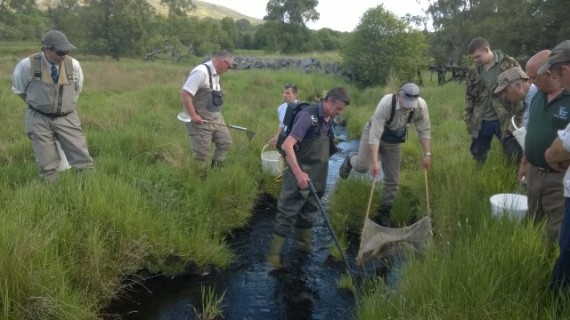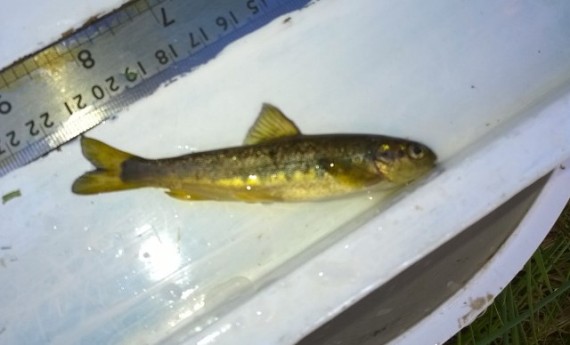Last night we enjoyed the company of a group of Spey ghillies who joined us during the monitoring of the stocking carried out in the Tommore Burn last year. Last September the ghillies fin clipped all the parr stocked in the burn therefore providing easy visual recognition of stocked fish.
After meeting at Ballindalloch Jimmy Woods eventually led us to the monitoring sites. We planned to repeat a couple of monitoring sites that we had surveyed in both 2012 and 2013. We set up the stop nets and from the start we caught fish, most of which were salmon parr. The habitat in the Tommore Burn is excellent with moss covered boulders and undercut banks. After we demonstrated the banner net operation the Craigellachie ghillies took control of the fish catching. Despite the banter about their relative, recent, lack of experience in netting fish they did a great job. The gusto with which Dougie Ross took to the task was a revelation; definitely biologist material there!

Steve assisted by the Craigellachie ghillies and Steve Brand electrofishing in the Tommore Burn. Chris can even do it standing on one leg.
The Tommore Burn (a tributary of the Avon) has been stocked upstream of an impassable culvert on the Glenlivet Road. It had been stocked previously in 2012 with salmon fry in June although they were not fin clipped. There was great interest in the fish and it turned out that all were fin clipped. The condition of the fish was very good and they ranged in size from 72mm to 103mm at the first site.

Not the best photo but this is one of the fin clipped fish stocked in 2013
None of the fish stocked in 2012 were found. Judging by the size of the fin clipped fish they are all likely to smolt as two year olds next year. If a parr reaches 90mm in length by the end of the growing season it is considered likely to smolt the following spring. Therefore in the Tommore Burn most of the stocked fish will be big enough to smolt as two year olds.
22 fin clipped parr were found in a stretch of the burn about 30m long in the first site with lower numbers in the second site. We normally find that we catch about 60% of the parr in the first run down a site so the actual parr population present would have been higher. A comparison of the salmon and trout densities in the two sites surveyed are shown below.

Site SA1b was the first site surveyed. I mentioned last night that the salmon parr density was probably in the excellent category but it didn’t quite make that, although good is what it says on the tin.
It can be seen that the density of salmon parr at both sites was higher this year than that recorded in 2013. There were quite a lot of salmon parr in the first site but the SFCC classification system for the Moray Firth region is demanding; it takes a lot of parr to make it into the dark green category. The trout parr density has declined in both sites. That is not unusual in stocked sites, the increased competition from the stocked fish often depresses the existing fish population, however experience has shown trout densities can recover quickly in the absence of stocking or even when stocked if environmental conditions favour trout.
All in all it was a very enjoyable evening. As with any type of culture the satisfaction of seeing the results of your efforts in the flesh never diminishes. No doubt every grilse in 2016, and every salmon in 2017 and even 2018 will be examined very carefully for the absence of an adipose fin!
Spey Fishery Board
